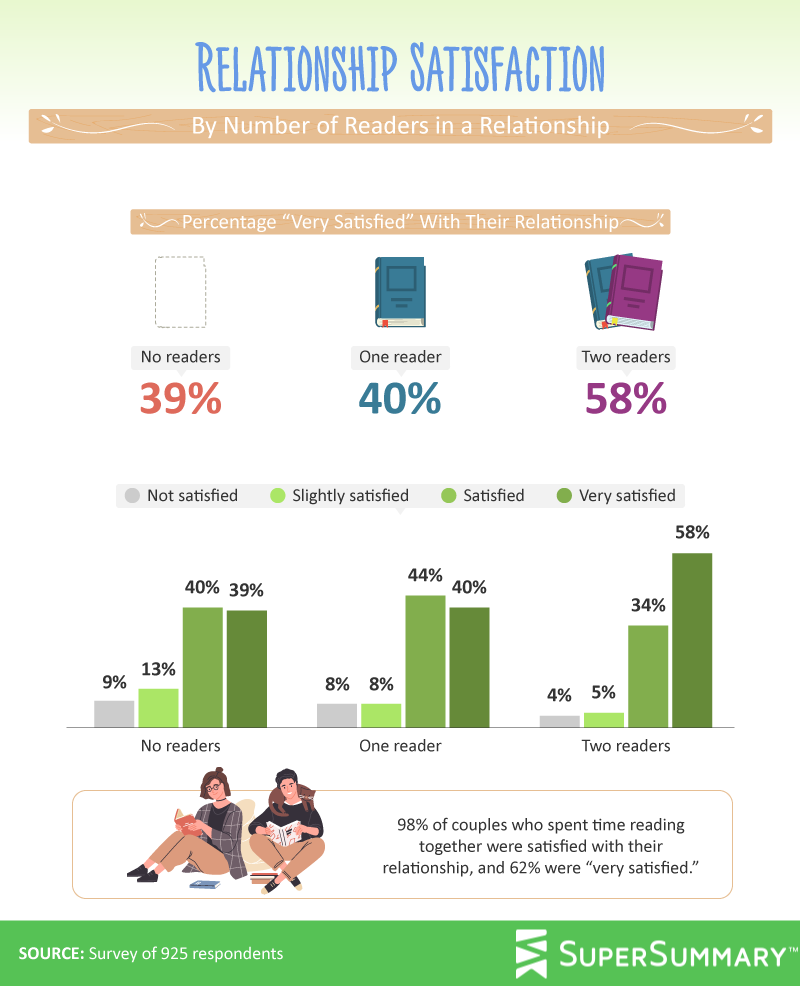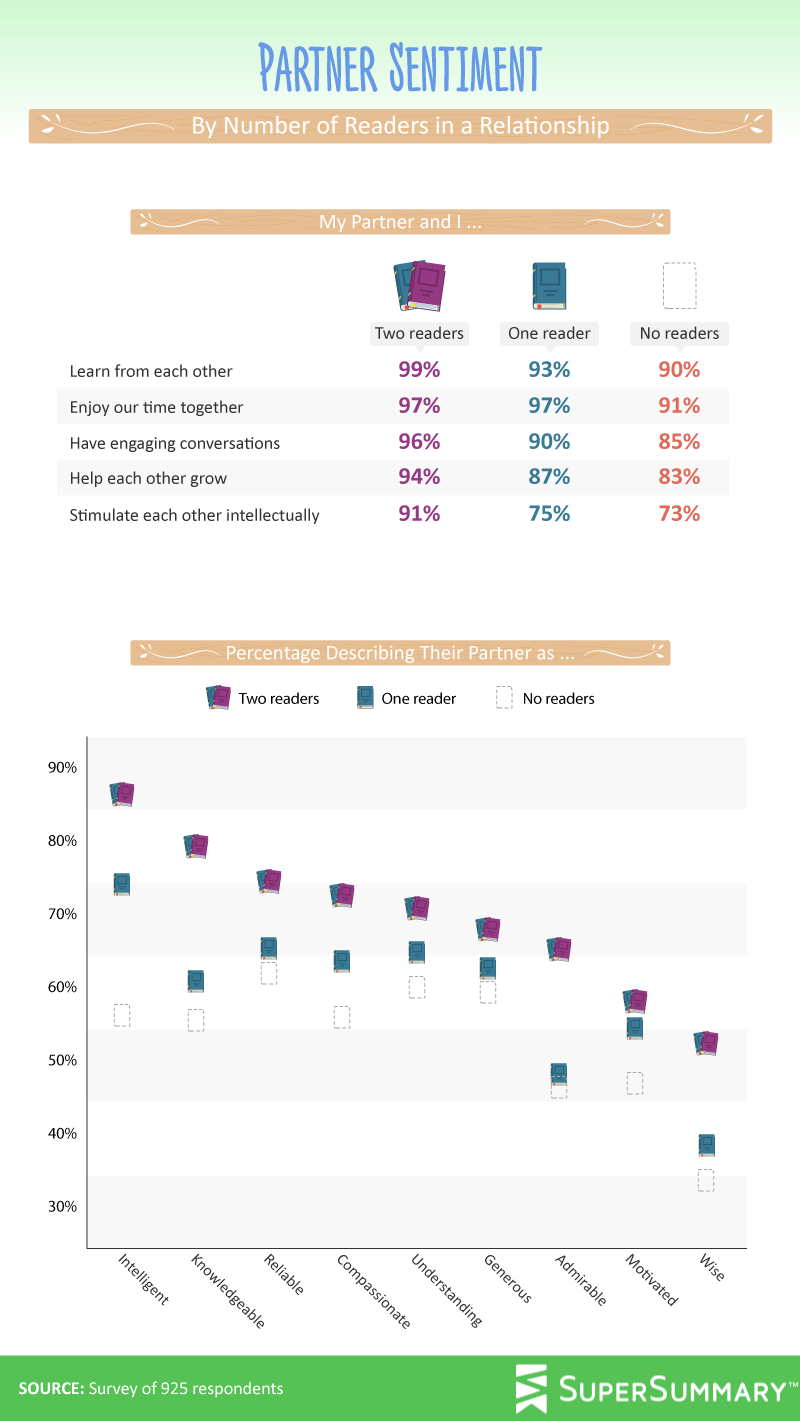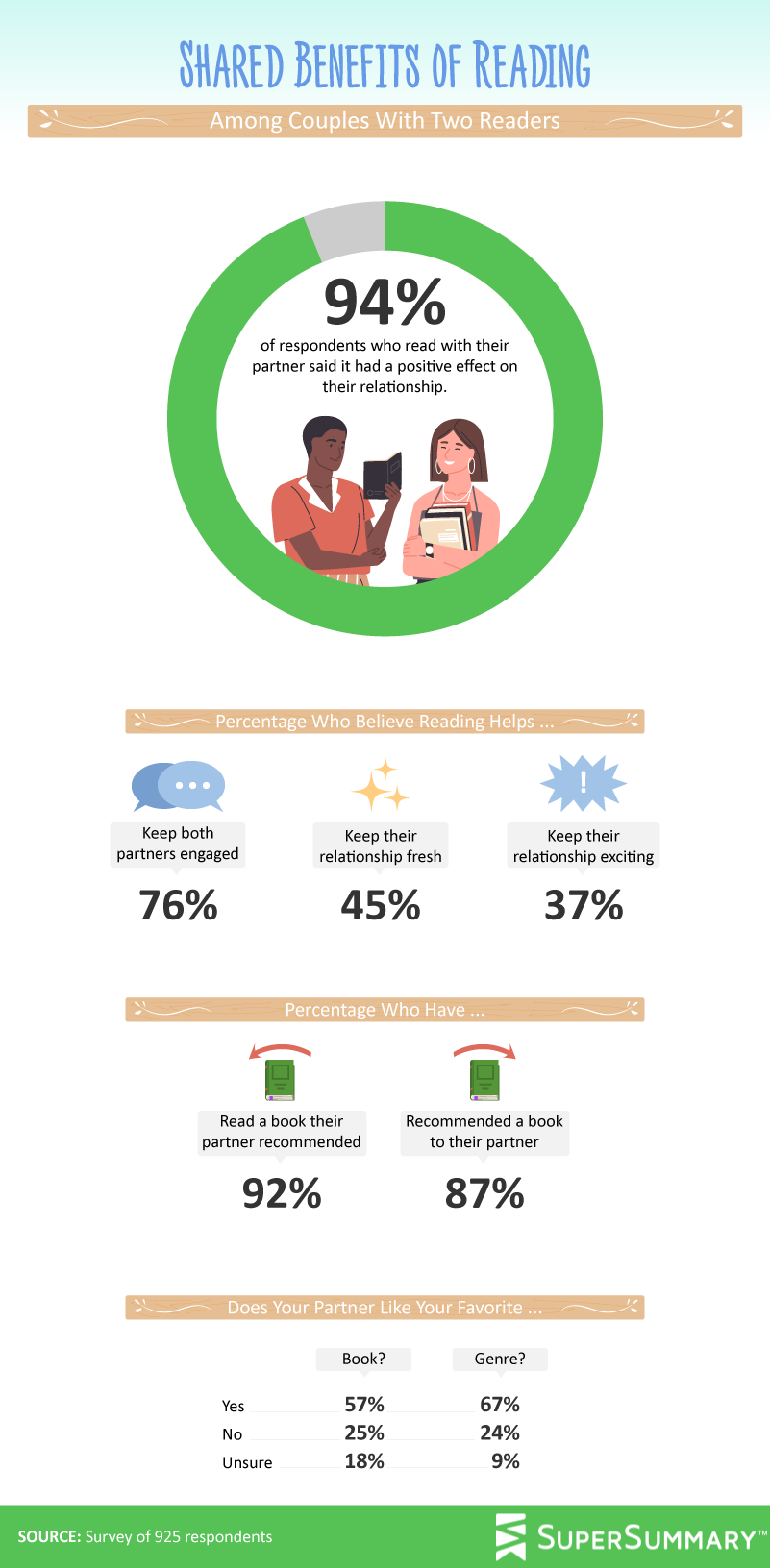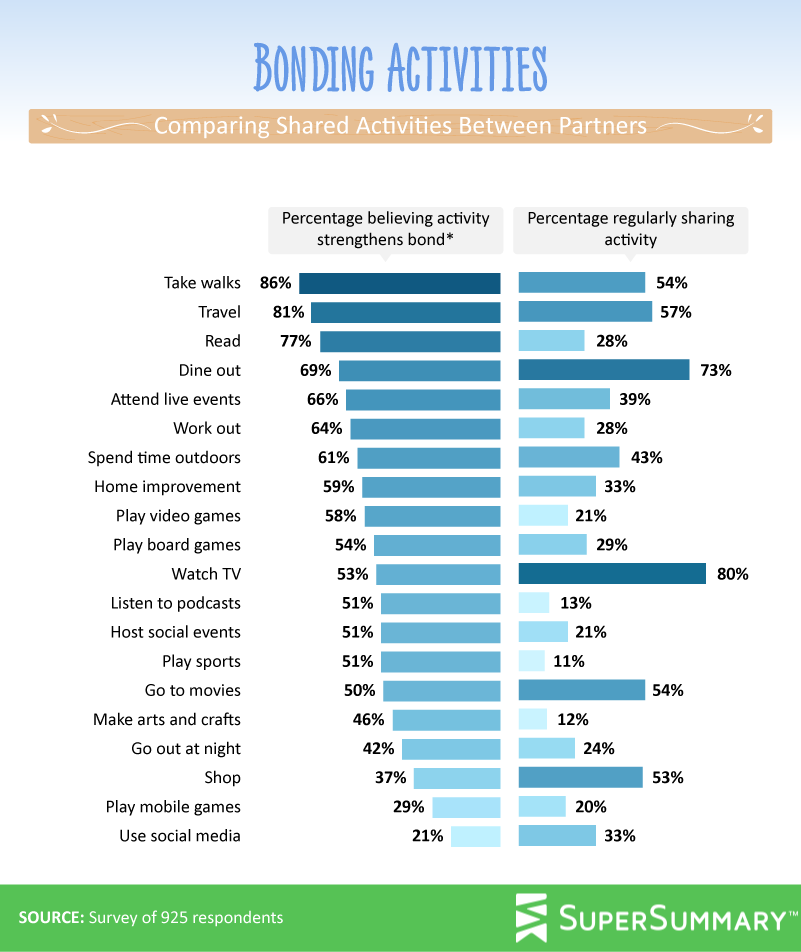the couple who reads together, stays together
Exploring the Relationship Benefits of Reading

Diving head-first into a good book can offer rewards far beyond the pleasure of reading a captivating story. Reading is shown to support strong empathetic qualities and stimulate creativity, among a wide range of other benefits that help us thrive. When avid readers meet other people, especially romantic partners, who connect with books the way that they do, the hobby can become a major pillar that brings two people together.
We surveyed nearly 1,000 people to see how many incorporate reading into their relationships and how the activity enhances those relationships. Continue reading to see how opening a book correlates to higher levels of satisfaction.
Reading and Relationships

To look at reading habits, we first needed to establish a base level of overall satisfaction among respondents, so we compared couples who didn’t read at all, couples with one partner who read, and partnerships where both people were readers. All in all, we found that readers tended to have better, more fulfilling relationships.
Nearly every person reported they felt satisfied, but the likelihood of satisfaction increased with the number of readers in the relationship. Further supporting this trend, we noticed that the percentage who felt “very satisfied” with their relationship also increased among readers: Not only were they more satisfied overall, but 58% of relationships where both partners read reported feeling “very satisfied,” compared to just 39% and 40% of couples where no one read and only one partner reads, respectively.
Among couples who took the time to read together, the results were even more uplifting. Ninety-eight percent were satisfied with their relationship, and 62% were even “very satisfied.”
 Attractiveness might be subjective, but we found that reading did impact someone’s overall appeal: 81% of women and 77% of men believed that being a reader was attractive. Furthermore, 89% of survey participants whose partner read claimed their partner’s reading habits made them more attractive.
Attractiveness might be subjective, but we found that reading did impact someone’s overall appeal: 81% of women and 77% of men believed that being a reader was attractive. Furthermore, 89% of survey participants whose partner read claimed their partner’s reading habits made them more attractive.
Relationships are extremely nuanced; couples can achieve great success no matter if they’re similar or polar opposites, but having similar tastes, especially with music, film, or literature, can help two people click. Our research found that couples who enjoyed similar genres were more likely to have satisfactory relationships than couples who primarily enjoyed different subjects.
Reading Helps Couples Grow Together

Beyond adding to a relationship’s overall satisfaction, we learned that reading can increase a partner’s likelihood of describing their significant other in highly positive terms such as intelligent, generous, reliable, compassionate, and understanding. Our data suggests that reading helps couples grow together, learn from each other, and stimulate each other intellectually, something that nonreading couples could improve on.
Couples who read together had better opinions of their partners and were more likely to think positively about their significant other in every trait for which we polled. The top characteristic, intelligence, is commonly attached to literary exploration. In fact, research shows that reading can boost overall intelligence and allows our brains to excel in other applications, such as reasoning and problem-solving.
 In one-reader relationships, the partner who enjoys a good book often hopes for their significant other to pick up the hobby. If you yearn for your partner to take up an interest in reading, start by asking them what genres they enjoy.
In one-reader relationships, the partner who enjoys a good book often hopes for their significant other to pick up the hobby. If you yearn for your partner to take up an interest in reading, start by asking them what genres they enjoy.
Reading Can Bring Happiness to a Relationship
 Overwhelmingly, respondents reported that reading had a direct and positive impact on their relationships. Some of these positive outcomes included: keeping couples engaged (76%), keeping relationships fresh (45%), and adding excitement to a couple’s dynamic (37%).
Overwhelmingly, respondents reported that reading had a direct and positive impact on their relationships. Some of these positive outcomes included: keeping couples engaged (76%), keeping relationships fresh (45%), and adding excitement to a couple’s dynamic (37%).
Sharing books can also help couples communicate in a unique way, such as discussing opinions about a book’s plot, facts, characters, or storyline. Additionally, when both people in the relationship enjoyed reading, they tended to gravitate toward each other to share this interest. We found that 75% of couples with two readers spent time reading together.
Only a quarter of respondents said their partner didn’t like their favorite book or genre, but 46% of people in two-reader relationships generally enjoyed the same genres.
How Reading Stacks Up to Other Activities

Reading landed just behind traveling and taking walks as the No. 3 activity that helped bring couples together: 77% of people surveyed believed their relationship was strengthened by reading together, yet only 28% reported actually taking the time to read with their partner regularly. Someone who respects reading’s value but doesn’t engage in the activity with their partner may feel disconnected and not know where to start – that’s nothing a recommended book can’t handle, though.
Speaking of disconnecting, few people reported that time spent on their phones had a positive effect on their relationship. 71% of respondents noted that playing mobile games with their partner didn’t strengthen their bond, and nearly 4 in 5 respondents said they didn’t feel that social media had a positive role in their relationship. As major platforms admit their role in users’ declining mental health, it would be wise for couples to evaluate the impact of social media (and phone use) on their relationships.
Reading: The Secret Relationship Enhancer
The personal love languages of many people can be intertwined with adoration for literature, and sharing that passion with a partner may open up new possibilities for connection and growth. Introducing reading to a relationship offers a new shared hobby to explore, and may even result in a deeper bond between a couple.
Want to add another level to reading with a partner? After finishing a book, sit down together and discuss and evaluate its impact and what it means to you. For suggestions on books that have made ripples in the literary world, head over to SuperSummary.com and review study guides that can help couples not only better understand the novel’s larger themes, but also their relationships.
Methodology and Limitations
We surveyed 925 people using the Amazon Mechanical Turk service. To ensure that respondents took our survey seriously, all respondents were required to identify and correctly answer an attention-check question. Our respondents ranged in age from 18 to 78 with an average age of approximately 37.6. To classify respondents’ and their partners’ reading habits, we relied on self-reported regular reading habits. 285 respondents were in a relationship where both partners read; 398 respondents were in a relationship where one partner reads; and 241 respondents were in a relationship where neither partner reads. Quotas were used to ensure sufficient sample sizes of each group, so the ratios between these groups are not proportional to the overall population. Our margin of error is 3% with a 95% confidence interval.
In many cases, questions and responses have been rephrased for clarity or brevity. These data rely on self-reporting, and strict statistical testing has not been performed on these findings. Potential issues with self-reported data include, but are not limited to, exaggeration, selective memory, and attribution errors on the part of respondents.
Fair Use Statement
Even though you may not be in school, reading is still cool. It’s an attractive trait and may even be the key to someone’s heart. Show off your reading skills and share this research as long as it’s shared with credit to us and for noncommercial purposes only.